Tape History
Table of Contents
- First Appearance of the concept
- Wire
- Metallic Tape
- Paper Tape
- Plastic Tape
- Refinement in the USA
- Bibliography

First Appearance of the concept
The first appearance of the magnetic recording of sound can be found in 1888,
in an article of "The Electrical World". It is written by Oberlin Smith, the president of the american mecanical
engineer society.
In "Some Possible Forms of Phonograph", he references the recent invention of the Bell phone and elaborates
on the subsequent reflexion :
if the discussion runs along a phone cable, a whole sentence could be contained on this wire. We would need
to fix it, to go from a time function to a space fonction.
Furthermore, storing a magnetic copy of the audio signal would avoid the electronic/mecanic conversion, which
was the norm at the time (with the wax cylinder of Edison).
The first Schematic shows a general system that contains all the fondamental elements that would be
developed and improved later :

- A - An acoustic / electronic transducer
- B - An electronic / acoustic transducer
- C - A wire / magnetic suppport
- D & E - Reels holding the wire
- F - Battery
- J - Rudimentary system to keep the wire in a constant tension
The motor rotating the reels is not figured. The whole system can be used for both writing and reading. The signal needs amplification for playing, thus the presence of a "X" on the drawing, electronical amplification hasn't been discoverd at the time. For the wire "C", Oberlin thought about a hard wire, cotton or silk, whose fiber would be mixed with iron powder. He also wrote about the sequential access problem : if we want an information in the middle of the reel, we need to unroll all the tape to the desired point. This problem is minor if you design a machine that can rewind fast enough, he anticipates the concept of tape transport, which will become a central part of later tape recorder. The work of Oberlin smith has been rediscovered in 1985, mutiple letters show that he did begin experimentations. Notably, we found reflexions on the coil used to write on the wire : in the first iteration, it was too wide and was "spreading" the magnetic potential on too big a zone. Later designs showed a coil wraped around a iron rod, which is closer to modern method.
Wire
Valdemar Poulsen (1869-1942) is the most cited as the "inventor of the magnetic recording".
He is indeed the first to launch the production of an operational magnetic gear and to present it to the
public.
He realised that ferromagnetic bodies could be magnetized in a very local way. This was in
opposition to the contemporary school of thought that argued that magnetisation would spread on the whole
body.
He is also the first to recognize the importance of the DC bias. It was already present on Oberlin's schematics as
a battery, but he did not notice the impact of this DC current on the quality of his sound.
Poulsen had probably read the works of Oberlin : "The Electrical World" was indeed a very reputable journal
in Europe.
Oberlin tried multiple times to get a part of Poulsen patent, whitout success.
In 1896, Valdemar design the first functional magnetic recording tools, he calls it the
"Telegraphone".
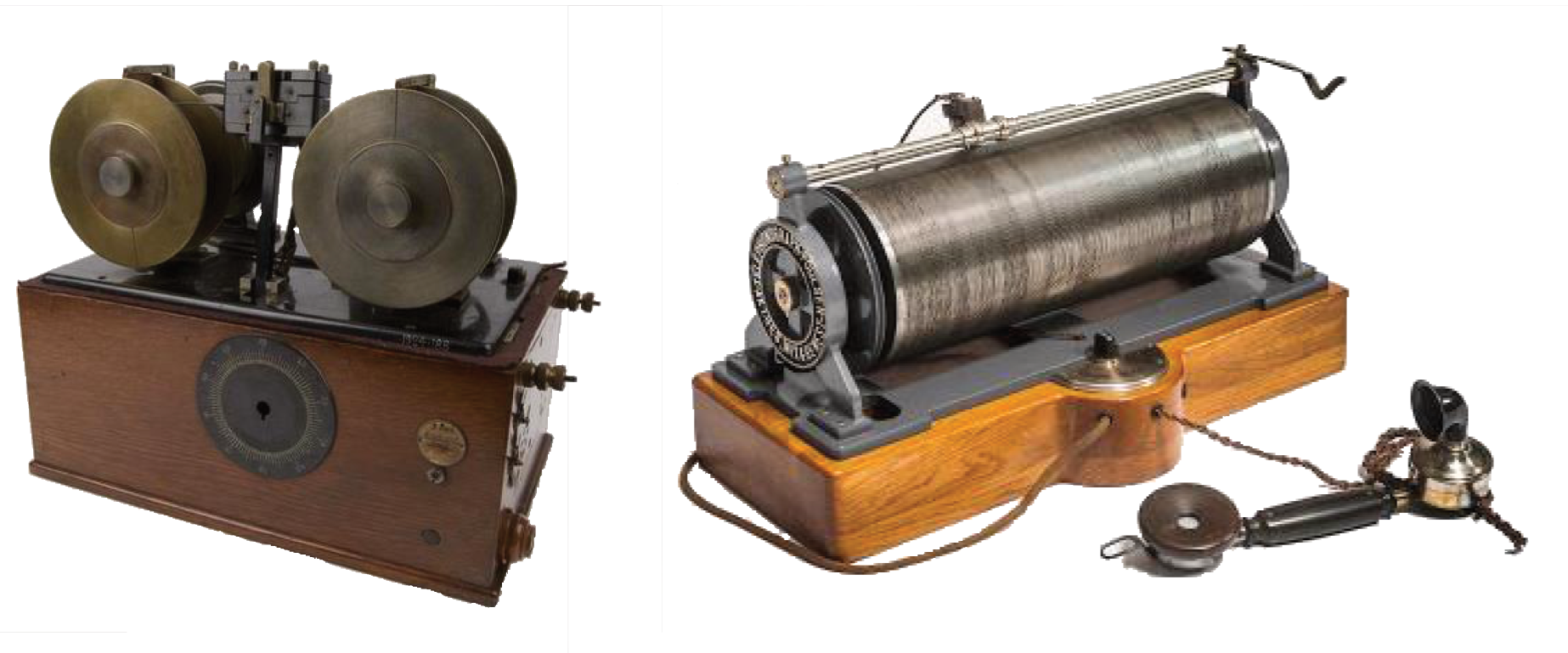 Two kinds of Telegraphone
Two kinds of Telegraphone
The wire recorder, patented in 1898, has been received with enthusiasm as the Paris Worlds fair 1900. In this occasion, the voice of Franz Josef, the emperor of Austria, has been recorded : it is the oldest magnetic recording that survived to this day. After this success, Valdemar developed numerous designs based on the concept. He also tried covering disks with magnetizable steel for short recording. The core of this system resembles the technic used today in some computer hard drives. The mecanical gramophone kept ruling the audio recording world for a long time, as the Poulsen's recorders failed to catch on. The limited electronics of the time, poor amplification and poor microphones meant that his system could not deliver sufficient results for widespread commercialization. The first suitable amplifiers were the tubes of the Australian Robert Von Lieben, whose 1910 patent already suggests the possibility of using his invention for magnetic audio recording. In 1913 in the USA, Lee Deforest, inventor of the "Audion" (another electronic tube), also wrote about the use of his amplifiers with the Telegraphone, which was a very useful tool for his tests.
Metallic Tape
The first Magnetic Tape (and not wire) was introduced in the 1920' by the chemist Curst Stille.
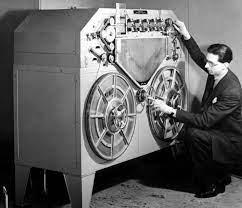
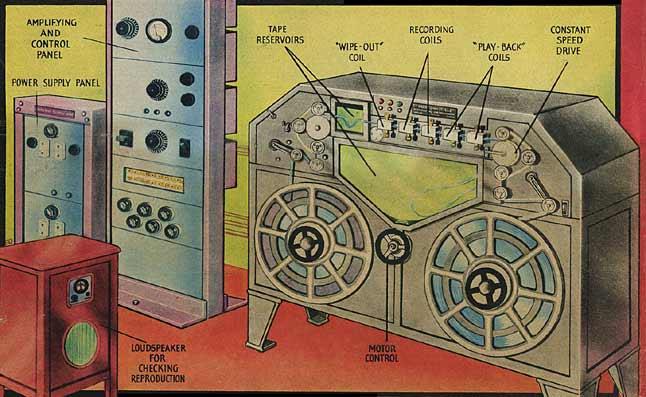
The tapes were made of metal, and the model used by the BBC used a reel weighing 9 kilos and 60 cm in diameter for 30 minutes of recording. The editing had to be done with a soldering iron. It introduced audible artifacts at each edit point as the tape lost all its magnetic potential when subjected to high temperatures. The equipment was also dangerous, as the tape ran at 1.5m meters per second. The machines were sometimes stored in cages to avoid any risk of accident.
Paper Tape
Plastic-based strips as we know them came later, the intermediate step between metal and plastic was the
paper tape.
Fritz Pfleumer was an engineer for a cigarette brand that applied a layer of gold to its filters.
During the economic depression of the '20s, he was asked to develop a technique to replace this gold coating
with a thin bronze layer.
As an audiophile, he was familiar with metal magnetic tapes and came up with the idea of using his process
to spray iron particles onto a 16-mm-wide strip of paper.
When Pfleumer developed the first paper tape, the competing recording media were the wax cylinder and the 78
rpm (ancestor of the 45 rpm).
The tapes of the time allowed continuous recording for up to 20 minutes, compared with 4 minutes for 78 rpm.
It became much easier to reuse the medium (it was possible to “shave” the wax cylinders, but it could not
be done many times).
The ability to easily cut and re-glue brought the start of editing, inaudible if done correctly.
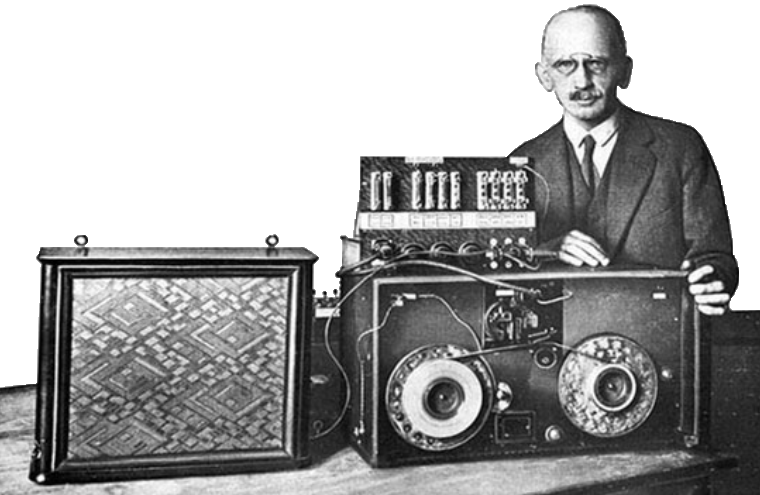
Pfleumer succeeded in making a functioning prototype in the years 1928-1929. The sound quality was very poor (partly due to the AC bias which had not yet been rediscovered). But the idea of being able to switch from a soldering iron to a pair of scissors prompted AEG (a German electrical equipment company) to take on the development of the tape in 1932. They took over the reins of the project, and from there went on to develop what was to become the standard for all subsequent machines.
Plastic Tape
After several attempts to develop a new tape formula, they contacted BASF, a chemical group that is part of the industrial conglomerate I.G. Farben (agfa, Bayer, etc...). In 1933, Eduard Schueller (an engineer at AEG) developed a ring-shaped head to replace the previous needle-shaped heads that tended to damage the tape. This new head creates an almost ideal magnetic flux, necessary for better fidelity. By 1935, German engineers therefore had three of the four essential ingredients for modern magnetic recording:
- stable transport for an even tape running
- an efficient, distortion-free magnetic head.
- A good magnetic tape.
They still lacked good electronics which would come later. The first tape recorder was presented by BASF and AEG at a Berlin exhibition in 1935. BASF called it the “Magnetophonband”. It was made for the world of professional and thus too expensive for most consumers. Sales took off and BASF invested in new machines to produce larger volumes of tape.
Magnetofon K4 - 1939 (right)
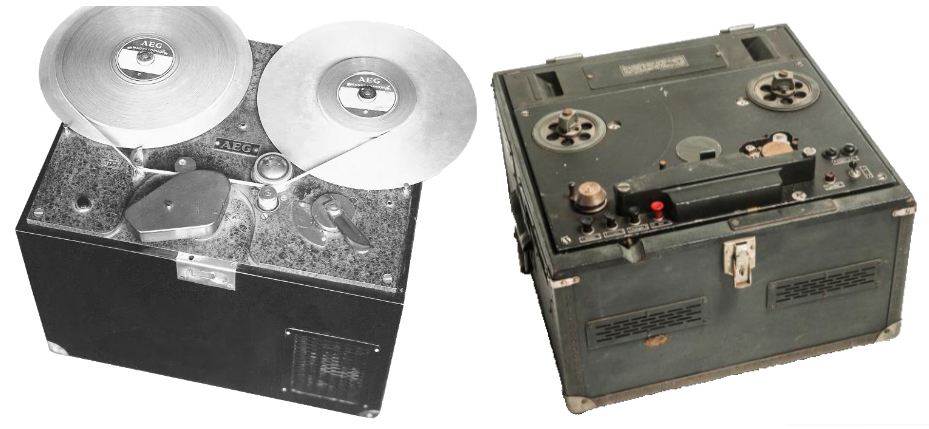
The scientists at BASF and AEG were groping their way along, their measuring equipment was rudimentary, and they had to establish the electronic, mechanical and magnetic quality parameters themselves, which they were often the first to define. At the time, measuring a hysteresis loop took between one and two hours, and producing 1,000 meters of tape more than 6 hours. Today, both operations take less than a minute. RRG (German Radio) played an important role in the development of this technology. They were the first engineers to experiment with machines, recording in the streets and on trains. In the 1930s, H.J. von Braunmuhl (head of the RRG's engineering section) asked Walter Weber (formerly a Siemens engineer) to improve the machines for broadcast use. Weber rediscovered AC bias in 1940, when an experimental denoising circuit went into oscillation and added a signal outside the audible range to the recording. AC bias has been discovered many times before, but in those days engineers were often unaware of advances made by other working groups around the world. Traces of this technique can be found as far back as 1927, when two navy engineers experimented with wire recorders.
In 1934, the first plastic tapes were designed with a cellulose acetate base of 30μm and a carbonyl iron layer of 20μm, all 5mm wide. This formula was easy to cut and edit, but strong enough to hold the torque of the transport motors. The formula is called Type C after the name of the base film: Cellite.
In 1935, carbonyl iron was replaced by iron oxide (Fe3O4). In 1939 was introduced the gamma iron oxide formula (γ-Fe2O3), which was not replaced until chromium dioxide in 1971. The magnetic particles of γ-Fe2O3 are much finer than those of the original Fe3O4 formula. The base film remained the same, cellulose acetate, which was sometimes replaced by PVC and polyester, especially after the destruction of the BASF Ludwigshafen plant in 1943 (which had the only machine capable of producing Type C). After this event, Agfa took over Type C tape production from BASF. Cellulose acetate continued to be used until the 1960s, partly due to its ease of production. The main ingredient is acetone, which is used at several stages of production and has the advantage of being inexpensive to produce and easy to obtain in large quantities.
Today's standards for tape width and reading speeds originate with AEG and BASF. In 1935, the tape width was increased from 5mm to 6.5mm for greater strength and magnetic performance. The playback speed was originally 1m/s for convenience, but after the selection of a new asynchronous motor from AEG and the establishment of a standard for capstan size, the combination of one with the other gave a new running speed of 76.8 cm/s. When American engineers recovered German technology after the war, they measured the characteristics of the equipment and were surprised to find almost 30 ips (76.2cm/s) for scroll speed and 1⁄4 of an inch (6.35mm) for tape width. These two values became industry standards with the start of production in the USA by Ampex and 3M.
Refinement in the USA
Jack Mullin was an American soldier deployed in World War II. During his night work, he listened to the radio and noticed that German channels had music of much higher quality than the BBC, with none of the record artifacts, crackling or noise of disk. After the takeover of Berlin and several other adventures, he finally arrived at the German radio station to discover the Magnetofon and its quality far superior to the American recorders. He returned to Paris and had the machine sent to himself as spare parts, with all the photos, diagrams and manuals, plus a large quantity of BASF magnetic tape. He presented the technology to several companies, and Ampex, which had been building engines during the war, seized the opportunity to reorient itself towards professional audio. They bought the technology and used their expertise in precision motors to develop more efficient transport systems.
The first “Magnetofon”-modelled Ampex came out in 1948 as the "Ampex model 200"
Ampex model 200
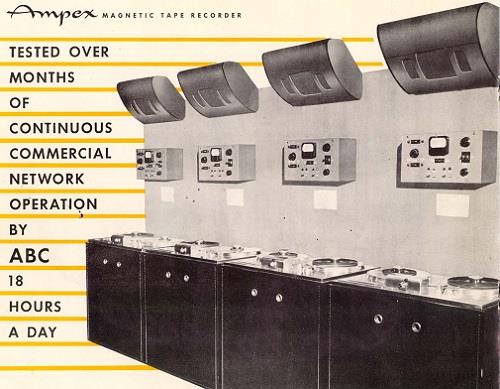 , and the first two
units were sent to Jack Mullin to be tested on the ABC channel for one of the first uses of tape in the US:
the Crosby show.
The tape greatly changed the production of the show, as the presenter sometimes didn't feel like doing the
show live, or on the contrary, wanted to record several shows in a row, which meant recording and
rebroadcasting. The disc was a very poor medium for editing and post-production, and there were
sometimes 2 or 3 iterations between recording and broadcast, which generated considerable distortion,
particularly of the voice (which is especially important in a musical show hosted by a charismatic
character). The tape thus provided a simple answer to many problems. Nevertheless, the disc
remained the final broadcast tool for some time, as it was considered more reliable than tape, which
could break.
, and the first two
units were sent to Jack Mullin to be tested on the ABC channel for one of the first uses of tape in the US:
the Crosby show.
The tape greatly changed the production of the show, as the presenter sometimes didn't feel like doing the
show live, or on the contrary, wanted to record several shows in a row, which meant recording and
rebroadcasting. The disc was a very poor medium for editing and post-production, and there were
sometimes 2 or 3 iterations between recording and broadcast, which generated considerable distortion,
particularly of the voice (which is especially important in a musical show hosted by a charismatic
character). The tape thus provided a simple answer to many problems. Nevertheless, the disc
remained the final broadcast tool for some time, as it was considered more reliable than tape, which
could break.
Mullin's importance should probably be put into perspective: primitive forms of tape recording already existed in the USA, and other soldiers had also brought recorders back from Europe, magnetic tape would probably have spread without his help.
The 1950s saw the emergence of amateur recordings, with the beginnings of consumer recorders, which used a slower running speed and more sensitive tape to reduce the cost of amplification components.
Bibliography
- AKAI Stereo Tape Deck Model GX-630D, 1-51
- AMPEX CORPORATION. AMPEX model 601-2 Operation Maintenance Manual, 2-3, 7-12
- Engel, F.K. (1988). 1888-1988: A Hundrer Years of Magnetic Sound Recording. Phonographic Bulletin, (51), 8-20
- Engel, F.K. (1988). Magnetic Tape, From the Early Days to the Present. Journal of the Audio Engineering Society, 36(7-8), 606-616
- Engel, F.K. (1990). Oberlin Smith and the Invention of Magnetic Sound Recording An Appreciation on the 150th Anniversary of the Inventor's Birth, 4-28
- Engel, F.K., Hammar, P. (2006). A Selected History of Magnetic Recording, 1-10
- Hammer, P., Ososke, D. (1985). The Birth of the German Magnetopho Tape Recorder 1928-1945, db, 28-36
- Magnecord INC. (1949). PT6-A INSTRUCTION MANUAL. 1-9
- McMUrray, P. (2017). Once Upon Time : A Superficial History of Early Tape. Twentieth-Century Music , 14(1), 25-48, doi: 10.1017/S1478572217000044
- Mullin, J.T. Creating the Craft of Tape Recording. Courthouse Facilities, 1-7
- Pivot, J.-C. (1995), A propos de l'enregistrement magnétique. Bulletin de l'Union des Physiciens, 89(777), 1657-1673
- Rouchouse, J. (2012, 4 août). La technologie des magnétophones analogiques. Restauration sonore. Consulté le 27 novembre 2022 sur http://restauration-sonore.over-blog.com/r
- Tape Bias. (2001, 30 septembre). Dans Wikipedia. https://en.wikipedia/wiki/Tape_bias
- Tape Transport. (2006, 16 mars). Dans Wikipedia. https://en.wikipedia.org/wiki/Tape_transport
- Thiele, H.H.K., (1988). Magnetic Sound Recording in Europe up to 1945. Journal of the Audio Engineering Society, 36(5), 396-406. http://www.aes.org/e-lib/browse.cfm?elib=19034